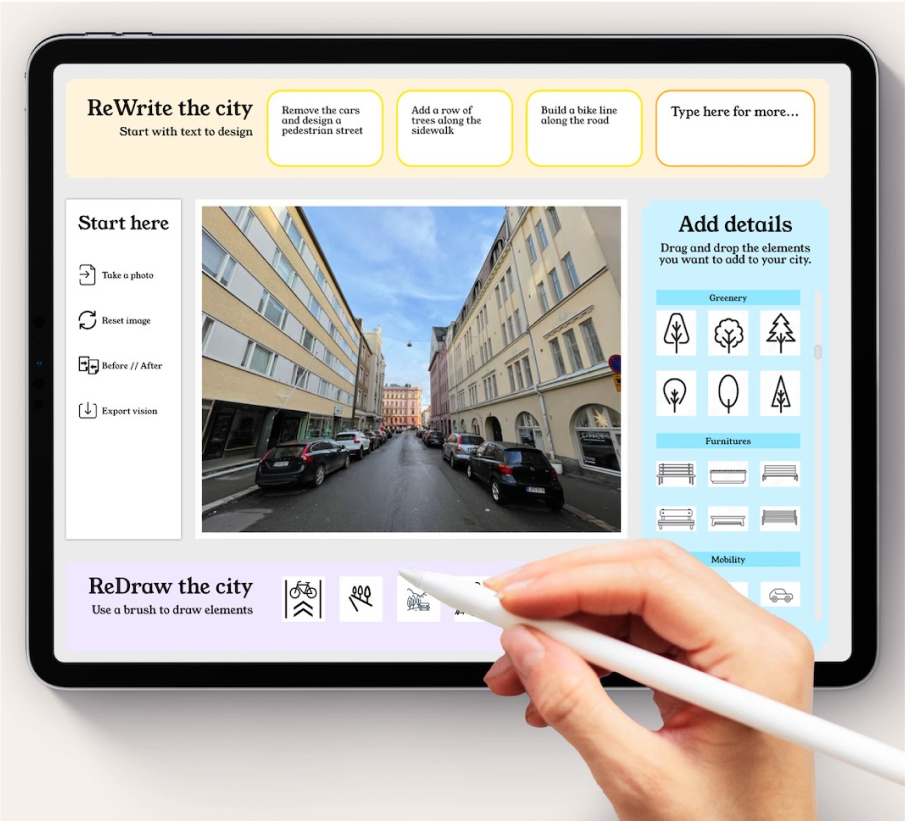The upcoming decades set out to be a rollercoaster humanity has never seen before. A boiling planet awaits. Ecological breakdown, technological disruption and occasional surprises pave ways and turnarounds that challenge our comfort zone of linear thinking.
This discontinuity requires great flexibility to recalibrate, reform, reconsider. People already hate it, for all the wrong reasons. Could we use AI as a diplomatic tool? The technology is now powerful enough for us to align on dreams, together. Let’s use it to inspire enough people for building bridges from our collective dreams into reality.

Our imagination is in crisis
We face multiple crisis on a planetary scale while the ground is constantly moving below our feet. There is external trauma (floods, fires, loss of wild life & livelyhoods) and internal trauma (adapting to new realities, admitting to hurtful behaviour within a destructive system). Looking at the big picture, this becomes paralyzing, too huge to handle.
You might struggle to see a way out of this situation. Most of us do, for various reasons. For one, it is very likely that imagination was trained out of you. Most educational systems are still rooted in a military/industrial 19th century mindset, argues Rob Hopkins in From What Is to What If (2019), which I highly recommend reading. In many schools we teach ourselves singular answers, leaving little wiggle room for creativity. Not the best conditions for a reality which demands lots of flexibility and readjustment.
And even though humans can be wonderful dreamers, we really struggle with non-linear thinking. The momentum behind tipping points, exponential progress and complex systems are difficult for us to grasp.
While this seems daunting and we have to move, fast, from experience I can assure you – once you start moving, the impossible becomes just another milestone to celebrate. But where do we start?
Encourage others to dream with you
Let me suggest an approach. We tackle one issue at a time, build towards the big picture like a puzzle that makes it enjoyable fitting the pieces together. We invite others to take part, to dream with us and inspire. We connect the magic of creative technology with actionable, accessible visions and experiences for our communities.
There is a saying »If you want to build a ship, don’t drum up people to collect wood, but teach them to long for the endless immensity of the sea.« Dreams create this longing. Even more, dreams are contagious. Dreams push us to think critically and creatively, to bring our very best ideas to the table.
Wanna join in? Welcome to the dream team.
There is no reason to describe only one path into the future. [...] We can do things very differently. [...] If we don't describe these spaces of possibility, we can't enter them. I find myself grounded, again and again, in this human potential.
Maja Göpel

The magic in the machine
I’ve been waiting for this moment for a long time. The text below is an example of a “prompt”, something that tells an algorithm what to imagine. Yes, we can imagine things now with a machine. These watercolor images are some of the outputs for this prompt.
/imagine
solar panels attached to a modern eco tiny house, solarpunk, cozy, illustration for a children's book in the style of Elena Degtyareva, watercolor, sketch style, --v 4 --q 2 --no tree, road, car, people, man, woman, child, animal
working...
done!



How does an algorithm dream?
Algorithms are trained on astronomic amounts of data. Artificial neurons, similar to neurons in the human brain, learn to distinguish features of objects, lighting, styles or relations between them. For example, they learn anything about a house or plant and that sometimes plants happen to be around or in a house. We can then ask the neuron model to imagine a house. Instead of copy-pasting bits and pieces “from memory”, the model will come up with its own remixed version, its best interpretation of a house.
In 2021, diffusion-based algorithms were made accessible to the public. In this process, noise (randomness) is added to training images and neuron models are asked to clean up these images with the guidance of a text description. After a lot of training, these models get so good they can “clean up" images which are pure noise. They are dreaming something into the grey fog like we would see shapes in a cloudy sky.
Here is an example of this process:

If you want to dive deeper, Vox did a great video explaining the tech and background of text-to-image algorithms – or see this section about AI basics.
2022 was an important milestone for AI generated content with algorithms like Dall•E 2, StableDiffusion, Midjourney, GPT-3 and ChatGPT hitting the mainstream. Anything beyond promises to be a wild ride.

Show, don’t tell.. your dreams
Let’s use these tools to bridge the gap between futures that could be, but are sometimes hard to imagine since we’re so used to the way things are. If we want to explore and push this solution space together, our visions have to be tangible and accessible enough. Only then they become actionable, ready to take the leap into reality. Accessible visions may take many forms: a good story, picture, movie or physical experiment.
Let me show you a few examples. If you’ve seen something that would fit well into this list, please let me know!
The best solutions are the ones that make a difference for you. If you are enthusiastic and engaged and enjoy what you are doing, others will engage or listen to you as well.
We know from neuroscience that action changes beliefs. So act - the most important thing is to do something.
Paul Hawken
Applications
The Twitter account @betterstreetai reimagined street scenery taken from Google Street View. Original on the left, reimagined on the right:

The Finnish project @UrbanistAI went another step and proposed an app for everyone to reimagine their neighbourhoods.

In 2022 we built the Mother Earth Telephone prototype. Acting as the wise character of Mother Earth, it provided an unique experience of direct conversation. The heart-shaped earth was created by AI as well.

Visualising your visions
I’ve been asked »What are the tools you’re using and how do I get such results?« – any AI list is out-of-date within a few weeks or months these days. Therefore I set up the dream collection for tools and tips. I’ll keep it fresh and ready to send over to anyone not on the dream team yet. Use it wisely.

I think @midjourney_ai is changing how I spend my free time. Instead of watching mindless junk when l'm tired, I'm getting back into music while making weird and pretty pictures, exploring the latent space of our collective imagination. It's an amazing tool and a lovely hobby.
[...]
Myth was a finely tuned psychotechnology that came from generations where we told each other stories by campfires. Generative Al is giving us a whole new way to have waking dreams. It is up to us to make this into a new kind of psychotechnology, and tune it for wholesomeness.
@metaphorician

Context & criticism
We can’t talk about AI without outlining open issues with the technology. Here’s what I worry about – there might be more..
Energy use & resources
Setting up OpenAI’s GPT-3 allegedly amounted to a 10 million USD electrical bill alone – training neural models is very, very computation intensive. Effort and therefore energy use with current algorithms is more or less proportionate to the model size. Larger models require more energy for training. And model size has been increasing, a lot. Once training is done, many models won’t need a server farm anymore and could run on your local machine. Processing still requires hefty amounts of energy though.
Societal bias, personal rights and copyright
A neural model learns what it is shown. Asking a neural model to imagine a health worker, the result is currently more likely to be female while the result for a banker is more likely to be male. Models reproduce social injustices, gaps and discrimination that are present in training data. There is already a healthy debate around AI bias, but it is up to us to keep challenging what we perceive and create.
Companies have repeatedly scraped data from the internet which was publicly available but protected under copyright law. Would you like AI’s to use and repurpose any or all of your personal data? Many artists resent the fact that their personal styles can be adapted and remixed, often not being asked if they wanted their art to be made available for AI training in the first place. We need consent and clarification around scraping and usage of our personal or copyrighted data.
Accessibility
New algorithms are published through scientific papers, however the strength of an AI typically lies within the trained model, training effort and data sets. As of 2023, trained models are barely made public or Open Source – StableDiffusion being an exception. Some are not even accessible outside of their research departments.
This is not only a business strategy. Some companies are concerned with AI getting so good, that publicly available models could attract too many malicious actors. Some argue, a more open process for society to experiment and adapt to these new tools is better than an exclusive or secret approach.
Disinformation & DeepFakes
Even just considering pictures, it’s hard to imagine where society will stand once the technology achieves a fully photorealistic quality. Which is basically right around the corner. Humans tend to see what they want to see and it’s becoming easier than ever to fool anyone. We’ll have to adjust to the need of content verification.

AI as an existential risk
Following the assumption that there’s no magic happening in our brains and similar systems could one day be built – humanity could soon face a challenge never ever encountered before: Dealing with systems or sentient beings more intelligent than us.
This rabbit hole goes deep and most paths seem surreal from our current perspective. Many are quite scary, existential-crisis-scary even. Nick Bostrom lays them out in Superintelligence: Paths, Dangers, Strategies (2014) and Tim Urban wrote the longpiece The AI Revolution: The Road to Superintelligence (2015) that got me into the topic to begin with.

And you?
What do you think? What do you dream about? Let me know in the comments. Or show me how you're using this technology. There are so many (!!) things we could reimagine:
Living. How could your neighborhood look and feel like? And your home? Who would be there? For whom should it feel inviting?
Interbeing. How do you see your relationships evolving? Could your connections with your surrounding change? What do you appreciate about the world and beings wandering around it? Who or what would you love?
Working. How would you like to work? Where? With whom? On what? Who would help you? How could it be organized?
Education. How could learning and playing be adjusted to prepare us for upcoming challenges? Who would need to be involved? Where would it happen? How could it be fun and egaging?
Interests. Are there any topics you would like to explore? Any ideas to sketch out? Something you’re passionate about to bring to life and share with the world?
Energy. How would a renewable energy future look like? Who would help building it? Who would own the infrastructure?
Food. How could we make food production regenerative and resilient? How could cultivating crops look like? Or sharing a meal?
Mobility. How would you envision long distance travel without kerosene? How could people in rural areas get where they need and want to be?
Economy. What would a circular economy look like? A regenerative company?
Culture. How would you like to relax, be entertained or inspired? How would you create?
All you need is a dream.


 and
and
No Comments.